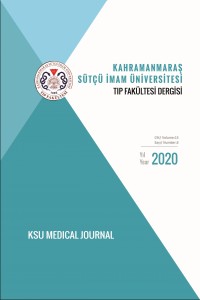KERATİNİZE MUKOZA EKSİKLİĞİ OLAN İMPLANT BÖLGELERİNİN OTOJEN YUMUŞAK DOKU GREFTİ İLE OGMENTASYONU; OLGU SUNUMU – 5 OLGU
Öz
Dental implantlar çevresindeki keratinize doku genişliği ve yumuşak doku kalınlığı uzun süreli implant stabilitesi, fonksiyon ve estetik için önemli iki faktördür. Peri-implant doku sağlığını korumak için minimum miktarda keratinize mukoza (KM ) ihtiyacı, tartışmalı bir konudur. Keratinize doku ogmentasyonları icin kullanılan otojen greft materyalleri serbest dişeti greftleri (SDG), subepitelyal bağ dokusu greftleri (SBDG) ve son yıllarda uygulanmaya başlanılan serbest periosteal greftleri (SPG)’ dir. Bu olgu raporlarında implant uygulaması yapılmış ve yetersiz yapışık KM mevcudiyeti olan implant bölgelerinin otojen greft materyalleri yöntemi ile ( SDG ve SBDG) ogmentasyonları yapılarak yeterli bir KM bandının oluşturulması amaçlanmıştır.
Anahtar Kelimeler
keratinize mukoza implant serbest dişeti grefti subepitelial bağ doku grefti
Kaynakça
- 1. Berglundh, T., et al., Morphogenesis of the peri‐implant mucosa: an experimental study in dogs. Clinical oral implants research, 2007. 18(1): p. 1-8. 2. Lin, C.Y., et al., Impact of timing on soft tissue augmentation during implant treatment: A systematic review and meta‐analysis. Clinical oral implants research, 2018. 29(5): p. 508-521. 3. Bassetti, R.G., et al., Soft tissue augmentation around osseointegrated and uncovered dental implants: a systematic review. Clinical oral investigations, 2017. 21(1): p. 53-70. 4. Thoma, D.S., et al., A systematic review assessing soft tissue augmentation techniques. Clinical oral implants research, 2009. 20: p. 146-165. 5. Souza, A.B., et al., The influence of peri‐implant keratinized mucosa on brushing discomfort and peri‐implant tissue health. Clinical oral implants research, 2016. 27(6): p. 650-655. 6. Linkevicius, T., et al., Reaction of crestal bone around implants depending on mucosal tissue thickness. A 1-year prospective clinical study. Stomatologija, 2009. 11(3): p. 83-91. 7. Puisys, A. and T. Linkevicius, The influence of mucosal tissue thickening on crestal bone stability around bone‐level implants. A prospective controlled clinical trial. Clinical oral implants research, 2015. 26(2): p. 123-129. 8. Wennström, J.L. and J. Derks, Is there a need for keratinized mucosa around implants to maintain health and tissue stability? Clinical oral implants research, 2012. 23: p. 136-146. 9. Baltacıoğlu, E., et al., Peri-Implant Plastic Surgical Approaches to Increasing Keratinized Mucosa Width: Which to Use and When? Journal of Oral Implantology, 2015. 41(3): p. e73-e81. 10. Small, P.N. and D.P. Tarnow, Gingival recession around implants: a 1-year longitudinal prospective study. International Journal of Oral & Maxillofacial Implants, 2000. 15(4). 11. Chung, D.M., et al., Significance of keratinized mucosa in maintenance of dental implants with different surfaces. Journal of periodontology, 2006. 77(8): p. 1410-1420. 12. Roccuzzo, M., G. Grasso, and P. Dalmasso, Keratinized mucosa around implants in partially edentulous posterior mandible: 10‐year results of a prospective comparative study. Clinical oral implants research, 2016. 27(4): p. 491-496. 13. Lin, G.H., H.L. Chan, and H.L. Wang, The significance of keratinized mucosa on implant health: a systematic review. Journal of periodontology, 2013. 84(12): p. 1755-1767. 14. Warrer, K., et al., Plaque‐induced peri‐implantitis in the presence or absence of keratinized mucosa. An experimental study in monkeys. Clinical oral implants research, 1995. 6(3): p. 131-138. 15. Hämmerle, C., et al., Plaque‐induced marginal tissue reactions of osseointegrated oral implants: a review of the literature. Clinical oral implants research, 1992. 3(4): p. 149-161. 16. Kim, B.-S., et al., Evaluation of peri-implant tissue response according to the presence of keratinized mucosa. Oral Surgery, Oral Medicine, Oral Pathology, Oral Radiology, and Endodontology, 2009. 107(3): p. e24-e28. 17. Yeung, S., Biological basis for soft tissue management in implant dentistry. Australian dental journal, 2008. 53: p. S39-S42.
Ayrıntılar
| Birincil Dil | Türkçe |
|---|---|
| Konular | Sağlık Kurumları Yönetimi |
| Bölüm | Olgu Sunumları |
| Yazarlar | |
| Yayımlanma Tarihi | 16 Ekim 2020 |
| Gönderilme Tarihi | 15 Ocak 2020 |
| Kabul Tarihi | 8 Mayıs 2020 |
| Yayımlandığı Sayı | Yıl 2020 Cilt: 15 Sayı: 3 |


